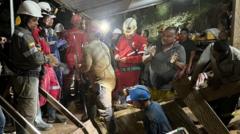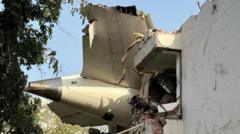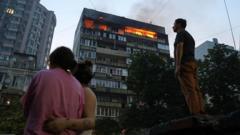New drone tests will provide vital assistance to Sherpas on Mount Everest, minimizing risks and maximizing operational efficiency for this year's climbing season.
Drones Set to Ease Burden on Sherpas During Everest Climbing Season

Drones Set to Ease Burden on Sherpas During Everest Climbing Season
Innovative technology aims to support mountain guides by transporting heavy loads, enhancing safety and efficiency.
In a groundbreaking initiative, Nepali Sherpas are set to receive much-needed assistance on Mount Everest as expedition companies prepare to test drones capable of transporting heavy loads through treacherous terrain. These advanced devices will be introduced as the climbing season kicks off next month, carrying weights of up to 35 pounds—slashing transportation time from seven hours to merely 15 minutes for essential items like climbing gear and ladders.
This transformative approach is not just about logistics; it’s a vital response to the increasing dangers Sherpas face. As the effects of climate change exacerbate conditions on the mountain—particularly with accelerated snowmelt—these drones are poised to enhance safety for guides who traditionally bear the heavy physical burdens of their foreign climber clients. "The drone makes their task safer, faster, and more efficient," highlighted Tshering Sherpa of the Sagarmatha Pollution Control Committee, an organization instrumental in ensuring safe passage through the perilous Khumbu Icefall.
Initial trials will utilize two drones donated from a Chinese manufacturer, following a year of experimentation. The forthcoming pilot test is crucial for demonstrating the technology's effectiveness, with the hope of persuading expedition agencies to invest in additional units. Although the upfront cost may appear high, supporters advocate that drones will ultimately streamline operations and reduce long-term costs.
As these efforts unfold, the focus remains on safeguarding the dedicated Sherpas who play an indispensable role in high-altitude expeditions. With hopes for more successful seasons ahead, the integration of drone technology symbolizes a promising step toward enhancing sustainability and safety in one of the world’s most challenging environments.
This transformative approach is not just about logistics; it’s a vital response to the increasing dangers Sherpas face. As the effects of climate change exacerbate conditions on the mountain—particularly with accelerated snowmelt—these drones are poised to enhance safety for guides who traditionally bear the heavy physical burdens of their foreign climber clients. "The drone makes their task safer, faster, and more efficient," highlighted Tshering Sherpa of the Sagarmatha Pollution Control Committee, an organization instrumental in ensuring safe passage through the perilous Khumbu Icefall.
Initial trials will utilize two drones donated from a Chinese manufacturer, following a year of experimentation. The forthcoming pilot test is crucial for demonstrating the technology's effectiveness, with the hope of persuading expedition agencies to invest in additional units. Although the upfront cost may appear high, supporters advocate that drones will ultimately streamline operations and reduce long-term costs.
As these efforts unfold, the focus remains on safeguarding the dedicated Sherpas who play an indispensable role in high-altitude expeditions. With hopes for more successful seasons ahead, the integration of drone technology symbolizes a promising step toward enhancing sustainability and safety in one of the world’s most challenging environments.




















